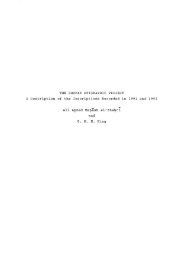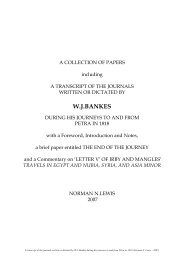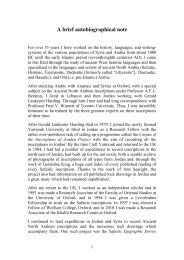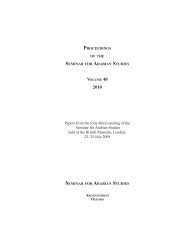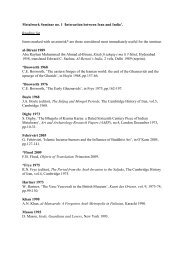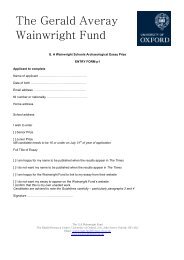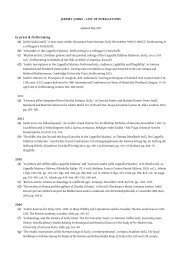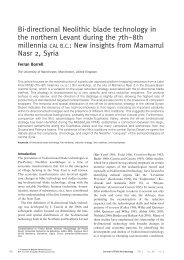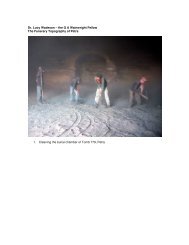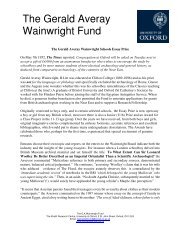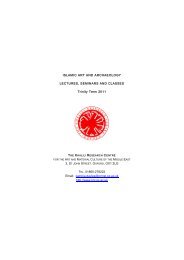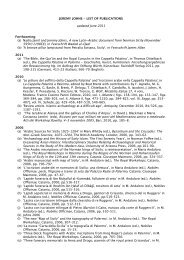W. J. Bankes and the Identification of the Nabataean Script - Khalili ...
W. J. Bankes and the Identification of the Nabataean Script - Khalili ...
W. J. Bankes and the Identification of the Nabataean Script - Khalili ...
You also want an ePaper? Increase the reach of your titles
YUMPU automatically turns print PDFs into web optimized ePapers that Google loves.
44 N.N. LEWIS <strong>and</strong> M.C.A. MACDONALD<br />
Syria 80 (2003)<br />
only Sinaitic inscriptions recorded by <strong>the</strong> expedition were twenty texts copied by its astronomer <strong>and</strong> surveyor,<br />
Carsten Niebuhr. 12 It was to be almost eighty years before <strong>the</strong> Sinaitic inscriptions were deciphered, on <strong>the</strong> basis<br />
<strong>of</strong> bad h<strong>and</strong>-copies, 13 <strong>and</strong> ninety years before <strong>the</strong> next expedition aimed at a systematic record <strong>of</strong> <strong>the</strong> texts. 14<br />
In his Reisebeschreibung nach Arabien, Niebuhr was one <strong>of</strong> <strong>the</strong> first to cast doubt on <strong>the</strong> antiquity <strong>and</strong><br />
significance <strong>of</strong> <strong>the</strong> inscriptions. He suggested that when <strong>the</strong>y were eventually deciphered <strong>the</strong>y would be found<br />
to be simply <strong>the</strong> signatures <strong>of</strong> travellers, as were <strong>the</strong> Greek texts he had seen in o<strong>the</strong>r parts <strong>of</strong> <strong>the</strong> Peninsula. 15<br />
The first person to make real progress in <strong>the</strong> study <strong>of</strong> <strong>the</strong>se texts was Edward Wortley Montagu, husb<strong>and</strong> <strong>of</strong><br />
<strong>the</strong> more famous Lady Mary, <strong>and</strong> former British ambassador to Constantinople. He travelled in Sinai in 1766<br />
<strong>and</strong> copied twenty-five inscriptions which he published in a letter to <strong>the</strong> Royal Society, <strong>of</strong> which he was a<br />
Fellow. 16 He argued that since <strong>the</strong> inscriptions were interspersed « with figures <strong>of</strong> men <strong>and</strong> beasts ... <strong>the</strong>y were<br />
not written by <strong>the</strong> Israelites; for if <strong>the</strong>y had been after <strong>the</strong> publication <strong>of</strong> <strong>the</strong> law, Moses would not have permitted<br />
<strong>the</strong>m to engrave images, so immediately after he had received <strong>the</strong> second comm<strong>and</strong>ment >. He continued,<br />
it will be difficult to guess what <strong>the</strong>se inscriptions are ; <strong>and</strong>, I fear, if ever it is discovered, <strong>the</strong>y will be found scarce<br />
worth <strong>the</strong> pains. If conjecture be permitted, I will give my very weak thoughts. They cannot have been written by<br />
Israelites, or Mahometans, for <strong>the</strong> above reason ; <strong>and</strong> if by Mahometans, <strong>the</strong>y would have some resemblance to some<br />
sorts <strong>of</strong>Cuphic characters, which were <strong>the</strong> characters used in <strong>the</strong> Arabicanguage, before <strong>the</strong> introduction <strong>of</strong><strong>the</strong> present<br />
Arabic letters. ... I think it <strong>the</strong>n not unprobable , that <strong>the</strong>y were written in <strong>the</strong> first ages <strong>of</strong> Christianity, <strong>and</strong> perhaps<br />
<strong>the</strong> very first; when, I suppose, pilgrimages from Jerusalem to Mount Sinai were fashionable, consequently frequent<br />
<strong>and</strong> numerous, by <strong>the</strong> new Christian Jews, who believed in Christ ; <strong>the</strong>refore, I should believe <strong>the</strong>m Hebrew characters,<br />
used vulgarly by <strong>the</strong> Jews about <strong>the</strong> time <strong>of</strong> Christ. I shewed <strong>the</strong>m when at Jerusalem to <strong>the</strong> Rabins ; <strong>the</strong>y were <strong>of</strong> <strong>the</strong><br />
same opinion, <strong>and</strong> thought 19, which is frequent, was a20.7<br />
This was a considerable advance. The <strong>of</strong> Jerusalem had deciphered <strong>the</strong> most common word in <strong>the</strong><br />
Sinaitic inscriptions (slm), <strong>and</strong> Wortley Montagu had worked out <strong>the</strong> approximate date <strong>of</strong> <strong>the</strong> texts (first to fourth<br />
centuries AD), if not <strong>the</strong> script <strong>and</strong> authorship.<br />
From now on <strong>the</strong> idea that <strong>the</strong> texts were simply <strong>the</strong> > <strong>of</strong> pilgrims or travellers became widely<br />
accepted, 18 though <strong>the</strong>re was still wide disagreement about <strong>the</strong>ir date <strong>and</strong> script. A decade later, Court de Gebelin<br />
republished Wortley Montagu's copies describing <strong>the</strong>m as Phoenician 19 <strong>and</strong> interpreting as ank (<strong>the</strong> Phoenician<br />
personal pronoun, ) <strong>the</strong> word which had already been correctly identified as slm. 20 However, Volney, who<br />
travelled in Sinai in <strong>the</strong> 1780s returned to <strong>the</strong> <strong>the</strong>ory that to <strong>the</strong>se pilgrims we must attribute <strong>the</strong> inscriptions <strong>and</strong><br />
clumsy figures <strong>of</strong> asses, camels, &c. engraven on <strong>the</strong>se rocks, which have from <strong>the</strong>nce acquired <strong>the</strong> name <strong>of</strong><br />
Djebel Mokattab, or <strong>the</strong> written mountain. Montague [sic], who travelled a great deal in <strong>the</strong>se countries, <strong>and</strong><br />
carefully examined <strong>the</strong>se inscriptions, is <strong>of</strong> this opinion; <strong>and</strong> Gebelin has lost his labour, in endeavouring to<br />
discover some mysterious meaning.21<br />
12. For an account <strong>of</strong> this part <strong>of</strong> <strong>the</strong> expedition see HANSEN 1964: 122-126, 137-138, 152-189. On 21st September, 1762, Niebuhr<br />
recorded hieroglyphic inscriptions at Serabit al-Khadem, which he thought was Jabal al-Mukattab, (1774-1837, I: 249, but see RUPELL<br />
1829: 267). The next day, he copied <strong>Nabataean</strong> inscriptions in <strong>the</strong> vicinity <strong>of</strong> a narrow pass which he calls Umm al-Riglayn (1774-1837,<br />
I: 250). On <strong>the</strong> copying <strong>of</strong> <strong>the</strong> inscriptions <strong>and</strong> Niebuhr's discussion <strong>of</strong> <strong>the</strong>ir origins see NIEBUHR 1174-1837, I: 237, 249-250 <strong>and</strong> pi.<br />
XLIX-L, <strong>and</strong> 1792, 1: 197, 200-202.<br />
13. See BEER 1840.<br />
14. See LOTTIN DE LAVAL 1855-1859. Unfortunately, Lottin de Laval's copies were extremely inaccurate <strong>and</strong> in many cases are<br />
unintelligible.<br />
15. NIEBUHR 1774-1837, I: 237, 250.<br />
16. WORTLEY MONTAGU 1766.<br />
17. WORTLEY MONTAGU 1766: 50-51.<br />
18. See <strong>the</strong> quotations below from Volney, Busching, Seetzen <strong>and</strong> Burckhardt, to which add E. Riippell, who was in Sinai in 1817,<br />
(1822: 531).<br />
19. COURT DE GEBELIN 1775: 479-480, pls XII <strong>and</strong> XIX. In this he was returning, though without acknowledgement, to <strong>the</strong> <strong>the</strong>ory<br />
first put forward by T.S. Bayer in 1727 (see below).<br />
20. COURT DE GEBELIN 1775: 480, 496.<br />
21. VOLNEY 1801, II: 230, n. [= VOLNEY 1787, II: 324, n.1]. Italics as in <strong>the</strong> original.



